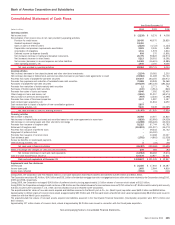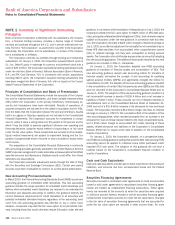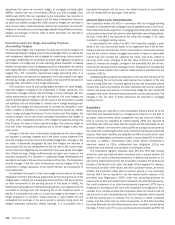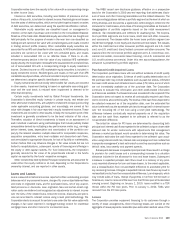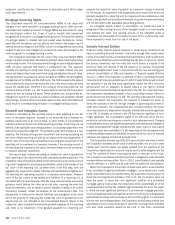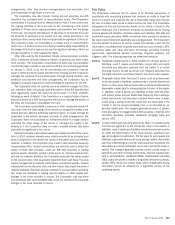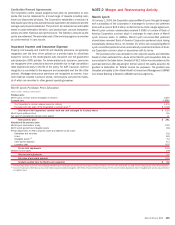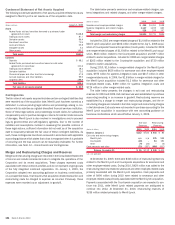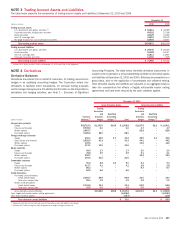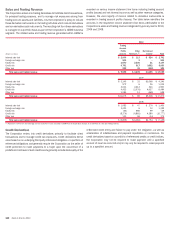Bank of America 2010 Annual Report Download - page 155
Download and view the complete annual report
Please find page 155 of the 2010 Bank of America annual report below. You can navigate through the pages in the report by either clicking on the pages listed below, or by using the keyword search tool below to find specific information within the annual report.arrangements, other than standard representations and warranties, that
could potentially be significant to the trust.
The Corporation may also transfer trading account securities and AFS
securities into municipal bond or resecuritization trusts. The Corporation
consolidates a municipal bond or resecuritization trust if it has control over
the ongoing activities of the trust such as the remarketing of the trust’s
liabilities or, if there are no ongoing activities, sole discretion over the design
of the trust, including the identification of securities to be transferred in and
the structure of securities to be issued, and also retains securities or has
liquidity or other commitments that could potentially be significant to the trust.
The Corporation does not consolidate a municipal bond or resecuritization
trust if one or a limited number of third-party investors share responsibility for
the design of the trust or have control over the significant activities of the trust
through liquidation or other substantive rights.
Other VIEs used by the Corporation include commercial paper conduits,
CDOs, investment vehicles created on behalf of customers and other invest-
ment vehicles. The Corporation consolidated all previously unconsolidated
commercial paper conduits in accordance with the new accounting guidance
on January 1, 2010. In its role as administrator, the Corporation has the
power to determine which assets are held in the conduits and the Corporation
manages the issuance of commercial paper. Through liquidity facilities, loss
protection commitments and other arrangements, the Corporation has an
obligation to absorb losses that could potentially be significant to the VIE.
The Corporation does not routinely serve as collateral manager for CDOs
and, therefore, does not typically have the power to direct the activities that
most significantly impact the economic performance of a CDO. However,
following an event of default, if the Corporation is a majority holder of senior
securities issued by a CDO and acquires the power to manage the assets of
the CDO, the Corporation consolidates the CDO.
The Corporation consolidates a customer or other investment vehicle if it
has control over the initial design of the vehicle or manages the assets in the
vehicle and also absorbs potentially significant gains or losses through an
investment in the vehicle, derivative contracts or other arrangements. The
Corporation does not consolidate an investment vehicle if a single investor
controlled the initial design of the vehicle or manages the assets in the
vehicles or if the Corporation does not have a variable interest that could
potentially be significant to the vehicle.
Retained interests in securitized assets are initially recorded at fair value.
Prior to 2010, retained interests were initially recorded at an allocated cost
basis in proportion to the relative fair values of the assets sold and interests
retained. In addition, the Corporation may invest in debt securities issued by
unconsolidated VIEs. Quoted market prices are primarily used to obtain fair
values of these debt securities, which are AFS debt securities or trading
account assets. Generally, quoted market prices for retained residual inter-
ests are not available, therefore, the Corporation estimates fair values based
on the present value of the associated expected future cash flows. This may
require management to estimate credit losses, prepayment speeds, forward
interest yield curves, discount rates and other factors that impact the value of
retained interests. Retained residual interests in unconsolidated securitiza-
tion trusts are classified in trading account assets or other assets with
changes in fair value recorded in income. The Corporation may also enter
into derivatives with unconsolidated VIEs, which are carried at fair value with
changes in fair value recorded in income.
Fair Value
The Corporation measures the fair values of its financial instruments in
accordance with accounting guidance that requires an entity to base fair
value on exit price and maximize the use of observable inputs and minimize
the use of unobservable inputs to determine the exit price. The Corporation
categorizes its financial instruments, based on the priority of inputs to the
valuation technique, into a three-level hierarchy, as described below. Trading
account assets and liabilities, derivative assets and liabilities, AFS debt and
marketable equity securities, MSRs and certain other assets are carried at
fair value in accordance with applicable accounting guidance. The Corporation
has also elected to account for certain assets and liabilities under the fair
value option, including certain corporate loans and loan commitments, LHFS,
commercial paper and other short-term borrowings, securities financing
agreements, asset-backed secured financings, long-term deposits and
long-term debt. The following describes the three-level hierarchy.
Level 1 Unadjusted quoted prices in active markets for identical assets or
liabilities. Level 1 assets and liabilities include debt and equity
securities and derivative contracts that are traded in an active
exchange market, as well as certain U.S. Treasury securities that
are highly liquid and are actively traded in over-the-counter markets.
Level 2 Observable inputs other than Level 1 prices, such as quoted prices
for similar assets or liabilities, quoted prices in markets that are not
active, or other inputs that are observable or can be corroborated by
observable market data for substantially the full term of the assets
or liabilities. Level 2 assets and liabilities include debt securities
with quoted prices that are traded less frequently than exchange-
traded instruments and derivative contracts where value is deter-
mined using a pricing model with inputs that are observable in the
market or can be derived principally from or corroborated by ob-
servable market data. This category generally includes U.S. govern-
ment and agency mortgage-backed debt securities, corporate debt
securities, derivative contracts, residential mortgage loans and
certain LHFS.
Level 3 Unobservable inputs that are supported by little or no market activity
and that are significant to the overall fair value of the assets or
liabilities. Level 3 assets and liabilities include financial instruments
for which the determination of fair value requires significant man-
agement judgment or estimation. The fair value for such assets and
liabilities is generally determined using pricing models, discounted
cash flow methodologies or similar techniques that incorporate the
assumptions a market participant would use in pricing the asset or
liability. This category generally includes certain private equity in-
vestments and other principal investments, retained residual inter-
ests in securitizations, residential MSRs, asset-backed securities
(ABS), highly structured, complex or long-dated derivative contracts,
certain LHFS, IRLCs and certain CDOs where independent pricing
information cannot be obtained for a significant portion of the
underlying assets.
Bank of America 2010 153




